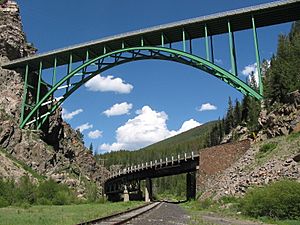Red Cliff Bridge facts for kids
Quick facts for kids Red Cliff Bridge |
|
|---|---|

Red Cliff Bridge (foreground)
|
|
| Coordinates | 39°30′30″N 106°22′36″W / 39.50833°N 106.37667°W |
| Carries | |
| Crosses | Eagle River |
| Locale | Red Cliff, Colorado |
| Characteristics | |
| Design | cantilevered steel arch bridge |
| Total length | 471 ft (144 m) |
| Width | 30 ft (9.1 m) |
| Height | 200 ft (61 m) (approximate) |
| Longest span | 318 ft (97 m) |
| History | |
| Architect | King Burghardt |
| Constructed by | F.M. Kenney |
| Fabrication by | Minnesota-Moline Power Implement Company |
| Construction begin | 1939 |
| Construction end | 1940 |
| Construction cost | $372,407 |
| Opened | 1941 |
The Red Cliff Bridge is a very special bridge in Colorado. It's located about half a mile southwest of the town of Red Cliff, Colorado. This bridge is known as one of Colorado's most famous bridges.
It carries U.S. Highway 24 over the Eagle River. It also crosses a county road and an old railroad track that goes towards Tennessee Pass and Leadville. The Red Cliff Bridge is one of only two steel arch bridges in Colorado. It's also the state's only cantilevered steel arch bridge. Because it's so unique, it has been listed on the National Register of Historic Places since 1985.
Building the Red Cliff Bridge
The Red Cliff Bridge was designed by King Burghardt. He was an engineer at the Colorado Department of Highways. The bridge was built by a contractor named P.M. Kenney in 1940. The steel parts for the bridge were made by the Minnesota-Moline Power Implement Company.
Building the bridge was very difficult. Workers had to hang over a 200-foot drop. The temperatures were often below freezing, sometimes even 0 degrees Fahrenheit. King Burghardt wrote in his journal about the tough conditions. He said workers spent the whole day high up in the air. The winter wind would constantly blow through the canyon.
Keeping the Bridge Strong
After more than 60 years, the Red Cliff Bridge needed a lot of repair work. This important work happened between March and November 2004. It cost $3.6 million to fix the bridge. The Federal Highway Administration helped pay for it, giving $1.6 million.
During the repairs, the bridge deck was replaced and made wider. Many of the steel parts were also repainted. Because the bridge is a historic landmark, great care was taken. The goal was to make sure it still looked the same as it always had. This careful repair work won an award in 2005. It received the National Steel Bridge Alliance Prize Bridge Award for the best Reconstructed Bridge of the year.

